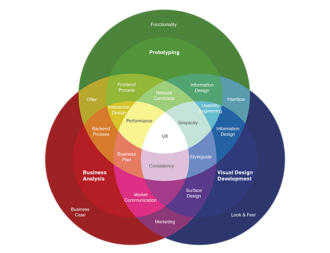As of 2020, more than half of website traffic came from a mobile device — a striking increase from 2013 when mobile accounted for just over 16 percent of worldwide traffic.
This giant uptick is the result of a critical mass of smartphone usage as well as the advancement of the cellular network technology that powers it — and researchers are predicting that this trend will only continue.
This development means a lot of things for a lot of different people. For anyone who has a digital presence, business, or organization — or works in a discipline that deals with creating and marketing products or services on the web — it means you need to get to know responsive design.
What is responsive web design?
Web designers used to make one website for desktop and another for mobile devices. But responsive web design is a way to design a website that seamlessly scales content and elements to fit the screen size of the device used to view it.
This means creating one flexible experience for every device a user may use to visit that website. The user experience might change in layout or presentation according to the size of the screen, but the website is the same no matter the device or browser.
The original responsive web design geek, Ethan Marcotte, found that after he designed desktop websites for his clients, they came back to him requesting that he also “make a website for the iPhone.” Marcotte, who coined the term and wrote the book Responsive Web Design, knew that he needed to develop a design that would make his websites appear and function the same way on mobile devices as they did on desktops.
What followed was the creation of a framework that responds to users’ needs and delivers a second-to-none experience that optimizes costs, saves web designers invaluable time, and translates to better results for the bottom line.
Pro Tip
With Jotform, you can create mobile-friendly forms that are responsive by default — for free!
What’s the purpose of responsive web design?
Mobile computing has exploded — there are 5 billion mobile devices in use today worldwide.
Industries across the board — in e-commerce, design, technology, publishing, and education — use responsive design because they can create just one website that reaches more people and more devices than ever before.
With the rapid rise in mobile usage, companies must deliver an experience to a user who might be accessing the website multiple times a day on whatever screen is at hand. A reader might view a newsletter on their desktop at home, subscribe to it on their laptop at work, and use their smartphone to send the link to a friend.
Responsive design makes the user’s experience of a website consistent no matter the device. The website doesn’t appear distorted on different screens, and the user doesn’t see any difference in the website’s appearance or have to take any extra steps, like pinching or zooming, to view it.
Businesses and other organizations will have lower maintenance costs with just one website to maintain, and pulling analytics reports will be easier. Your pages will load faster on mobile devices, helping you avoid the bounce factor connected to slow-loading content.
And you can’t argue with Google. Google’s mobile-first indexing is an important algorithmic development that promotes the use of responsive web design by ranking mobile-friendliness. Google’s bots will first take the mobile version of a website for indexing and ranking in the search engine results pages (SERPS). This approach is a significant factor driving responsive development.
How responsive web design works
With responsive web design, the website adapts so that it looks and works the same on each and every device.
Responsive web design’s flexible canvas changes the shape of content and images on the website to make them accessible to screens both small and large. It uses flexible grids, flexible images, and media queries. Responsive design syncs the layouts, graphics, and images to respond to the user’s device. Fluid grids, also called liquid layouts, scale to suit the user’s screen.
Responsive web design’s CSS3 media queries instruct the website to collect data from the site’s visitor and then implement CSS styles that tell the website software which design to respond with. The CSS will tell the user’s browser to respond with a flexible image that suits the user’s screen. The website responds to the user’s environment.
With responsive web design, the layout of a company’s website may look a little different on a desktop computer than it does on a smartphone. On the cell phone, the grids may have recalibrated to a vertical preference layout, but all of the same information will be there in pretty much the same order.
Responsive web design examples
Audi.com is cited as the first example of a responsive website. All the way back in 2002, the company recognized that developing fixed-size web pages was neither good practice nor forward thinking.
Even higher education institutions are adopting responsive web design, conscious that the first impressions they make will likely be on a prospective student’s cell phone. Millennials and those who are younger were practically born into this technology, and they have expectations for mobile website response. If they can’t get it on their cell phone, they’ll pass it by.
Companies across industries are getting high marks for their responsive web design, including International Energy Agency, Financial Times, and Illy.
Responsive web design is essential to the viability of any business. Not only does it allow your website to respond to the myriad devices of today, but it also allows for the potential capability to respond to mobile devices of the future. It’s become the basic starting point in modern website design.
























Send Comment:
5 Comments:
More than a year ago
Greeting
Very interesting, thanks for sharing such a good blog.
More than a year ago
You are doing well with your posts you will lead the software world with such a level of knowledge. Get in touch with a trusted company that could make your mobile app development successful.
Our website:- android app development company uk
More than a year ago
That's really nice information. In today's time website has to be responsive. It will very helpful to increase user experience.
Thank you for sharing.
More than a year ago
That's really nice post. I appreciate your skills. Thanks for sharing.
More than a year ago
responsive web design is a way to design a website that seamlessly scales content and elements to fit the screen size of the device.